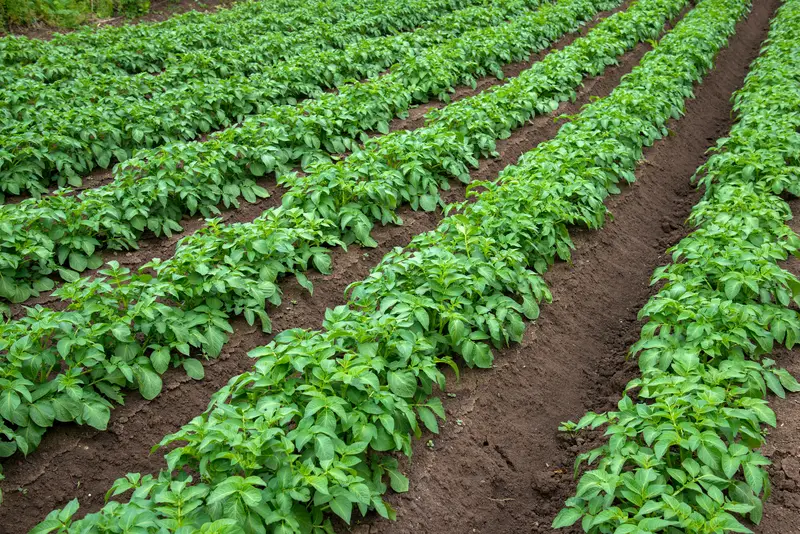Introduction
Potato’s growing success will be in your touch if you just look after your plants from the very beginning. Potato plants naturally turn yellow at the end of its growing season, so, if your case is like this, do not fret.
But if the plant is yellowing before the tubers are ready for harvest, your plant is facing some difficulties. ‘What can be the difficulties and how you treat them?’ this question will rub-off from your mind at the end of this article.
Let’s go!

What Causes Are Potato Plants Turning Yellow?
We will talk about the symptoms and solutions, before that, you better have a look at this short list containing the common causes why potato plants turn yellow:
- Verticillium wilt
- Fusarium wilt
- Insects
- Fungal disease
- Viral disease
How To Get Rid of Yellow Potato Plants?
Here you go with the details of problems with productive solutions.
Verticillium Wilt
If verticillium wilt attacks your potato plant, how will you find it out? Well, this disease causes the lower leaves of your plant yellow and wither. Generally, it infects through roots and then takes over the plant’s water-conducting tissues. Eventually, it will cause a wilt issue.
The very early symptom is characterized by unilateral leaf yellowing.
The symptoms of infection will continue spreading upward until the entire plant is yellowed and wilted. Moreover, the vascular tissue of your potato plant stems may also become light brown. This will be seen best at the ground level. Some of the tubers can be discolored near the stem end.
Solution: Cultural controls should be- rotating with weed and volunteer-free alfalfa or cereals. Apply nitrogen fertilizer to reduce the symptom’s severity. Also, try to keep the soil water availability 75%-100%.
For chemical controls, apply metam potassium or metam sodium in combination with Telone II.
Fusarium Wilt
Fusarium wilt symptoms are almost the same as verticillium wilt. But hence, with fusarium wilt, the tissue between the leaf veins will turn yellow. Basically, fusarium wilt is a soil-borne pathogen. Fungi will enter through the roots of your plant. Then the infection will spread up into the stems and leaves that restrict water flow causing the foliage wilting and turning yellow.
Symptoms may appear later in the growing seasons and you will first notice them on the lower, older leaves. Over time, when the disease progresses, the younger leaves will be affected too. Symptoms of fusarium wilt are more severe during hot weather, especially when the plants are water-stressed.
In some of the cases, only one side or brunch of the plant shows symptoms.
Solution: To get rid of fusarium wilt, remove the stricken growth from your garden and sterilize pruning clippers between cuts. Applying organic fertilizers will decrease the susceptibility to the disease.
Insects
Potato psyllids are light grey-green or dark brown or black-winged insects (almost the size of an aphid). They are less than 1 inch long and resembles leafhoppers or aphid.
Potato psyllids can harm your crop in more than one way. This disease will severally affect potato plant growth and yield. The bacterium will cause sugar to accumulate in the tuber areas rather than accumulating starch. Therefore, these areas will turn into black and create a characteristic pattern named ‘zebra chip’.
Solution: To detect the very first movement of the first potato psyllids, you can use yellow sticky traps placed at the field margin near the tops of the plants early in the season. Otherwise, apply insecticides to get rid of it.
Fungal Disease
The most common fungal disease of potato plants is ‘late blight’ caused by the fungus Phytophthora infestans. According to its name, the disease happens later in the growing season with symptoms that generally not appear until after blossom.
At the very first days, late blight appears on the older, lower leaves as gray-green spots, water-soaked. Over time, the disease matures and the spots darken. However, the yellow border surrounds the lesions after a long time from the infection.
Solution: Apply a copper-based fungicide every 7days or less after heavy rain or when the amount of disease starts increasing rapidly.
Viral Disease
Potato yellow dwarf virus is widely transmitted by leafhoppers. Affected potato plants will show dwarfing and the necrosis of the upper axillary buds will be seen. The stalk will become yellowish-green. When the disease progresses, the yellow color will predominate.
The plants affected by yellow dwarf will produce fewer as well as smaller tubers on short stolons.
Solution: To prevent potato yellow dwarf virus, plant disease-free seed potatoes. Must destroy the diseased plan as well as control leafhoppers.
Frequently Asked Questions
Question: Are yellow leaves a sign of overwatering?
Answer: Both overwatering and underwatering can cause leaves turning yellow. When plants can’t get enough water, they drop leaves to conserve water. But, before the leaves drop, they will turn yellow. On the other hand, if you water too much then the soil will not drain well. Thus, the lower leaves will turn yellow.
Question: Is a lack of light can turn the leaves yellow?
Answer: Yes, plants that get too little light will start to yellow on the lower leaves, and over time, the leaves will drop.
Question: Is normal aging responsible to turn the leaves yellow?
Answer: Yes, many plant’s yellow leaves are just a natural part of their growth. In such a case, there’s nothing to worry about.
Conclusion
So, here we are ending today’s discussion. Thanks to you if you still are with us. We hope that after reading this article, you have a crystal clear idea about why your potato plants turning yellow and what is left to solve this problem.
Okay, you are welcome!
However, at the end of the article, we would like to suggest you take extra care of your potato plants from the very first days. It will reduce your future suffering.
Wish you good luck.
As an Amazon Associate I earn from qualifying purchases.

